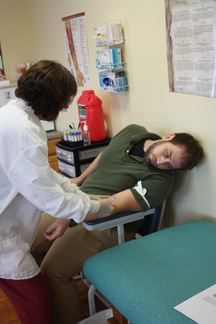Eight Questions Every Phlebotomist MUST Answer Correctly: #6
How do you anticipate fainting?
by Dennis Ernst • June 01, 2021

Question: How do you anticipate fainting?
You should. Studies show that up to five percent of patients will pass out during or immediately following a blood collection procedure. The problem is they don't come with a warning label on their forehead. It's no wonder the CLSI standards state precautions against patients losing consciousness on no fewer than six occasions in its venipuncture standard. How do you show that you're anticipating a loss of consciousness in every patient?
1) You're making sure every patient you draw is either lying down or seated in a chair with armrests to prevent sideways falls. Because the standards require it, you're never drawing patients who sit upright in their hospital bed or on an exam table. If you do home draws, you don't let your patient sit in a kitchen chair, or any other seat, without arm support. You're either moving them into a safer chair or you're having them lie down.
2) You're never more than an arm's reach away from patients while they are in your care. In case they pass out and fall forward, you're always there ready to secure them and you always keep the patient at least in the corner of your eye. That's because you know that a loss of consciousness can come without warning.
3) You ask patients if they've ever "had problems" getting their blood drawn. A person's history is one of the best indicators of their future behavior. If the answer is "yes," you convince them to lie down for the procedure. But never use the words "faint" or "pass out." Studies show if you use such suggestive words it nearly doubles the chance it will happen.
4) Before releasing them from your care, you ask patients if they feel all right. Their answer can reveal that they're feeling dizzy or on the verge of a vasovagal reaction that can lead to a loss of consciousness. Not every patient is willing to admit they feel a little lightheaded; those who don't may welcome the invitation to tell you. If the patient indicates that he doesn't feel so well, provide a cold compress to the back of the neck or forehead, lower the head below the plane of the heart or, if assistance is available, lay the patient on the floor or nearby cot. Do not allow the patient to walk. If the patient doesn't look so well but says he feels fine, don't buy it. He's probably too ashamed or embarrassed to admit it.
5) You look for signs. Symptoms include pallor, perspiration, anxiety, lightheadedness, hyperventilation and nausea. Talkative patients suddenly become quiet. All these signs can preempt a loss of consciousness. Ask patients if they feel all right, but don’t rely on verbal responses completely. Often, patients who pass out are as surprised as you are.
Despite your vigilance, sometimes patients pass out anyway. If this happens during a collection, release the tourniquet and remove the needle at once. Keep the presence of mind to activate the sharp's safety feature to avoid an accidental needlestick. Prevent the patient from falling to the floor and summon assistance. If possible, lower the patient's head below the level of the heart to facilitate blood flow to the brain. Avoid the use of ammonia inhalants since patients who may be asthmatic could develop respiratory distress.
Failure to anticipate fainting in every patient lessens the chances of protecting a patient from injury. Because it is a known risk of the procedure, patients have a right to expect that you are prepared to protect them from a fall that could ensue. Therefore, every healthcare worker who draws blood should expect every patient to pass out.
Correct answer: Yes, I anticipate fainting by positioning patients in either a reclining position or in chairs with arm rests that provide support, by keeping within arm's reach, by remaining vigilant to the signs of an imminent loss of consciousness, by asking patients if they've ever had "problems" with prior blood draws, and by making sure they feel all right before releasing them from my care.
Anxious for the rest of the questions? I've compiled all eight into one of our most popular downloads, "Eight Questions Every Phlebotomist Must Answer Correctly."
Related Posts and Information
overall rating: my rating: log in to rate
ammonia faint fainting lose consciousness pass out YouTube
